
Euphorbia is a very large and diverse genus of flowering plants, commonly called spurge, in the family Euphorbiaceae. "Euphorbia" is sometimes used in ordinary English to collectively refer to all members of Euphorbiaceae, not just to members of the genus.

Kirstenbosch is an important botanical garden nestled at the eastern foot of Table Mountain in Cape Town. The garden is one of 10 National Botanical Gardens covering five of South Africa's six different biomes and administered by the South African National Biodiversity Institute (SANBI). Prior to 1 September 2004, the institute was known as the National Botanical Institute.

The wildlife of South Africa consists of the flora and fauna of this country in southern Africa. The country has a range of different habitat types and an ecologically rich and diverse wildlife, vascular plants being particularly abundant, many of them endemic to the country. There are few forested areas, much savanna grassland, semi-arid Karoo vegetation and the fynbos of the Cape Floristic Region. Famed for its national parks and big game, 297 species of mammal have been recorded in South Africa, as well as 849 species of bird and over 20,000 species of vascular plants.
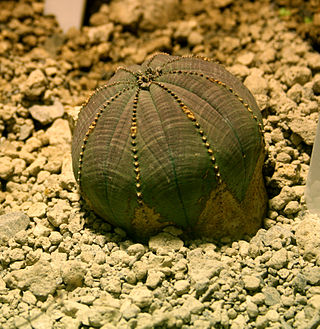
Euphorbia obesa is a subtropical succulent species of flowering plant in the genus Euphorbia. It comes from the south-central Cape Provinces of South Africa. Sometimes referred to as the baseball plant.

Euphorbia caput-medusae is a plant of the genus Euphorbia that occurs in and around Cape Town, South Africa.

The Harold Porter National Botanical Garden covers almost 200 ha between mountain and sea, in the heart of the Cape Fynbos region within the Kogelberg Biosphere Reserve to the east of Cape Town, South Africa, specifically near Betty's Bay along Clarence Drive (R44). With about 1,600 plant species, the area contains a floral diversity per unit area that is greater than anywhere else in the world. The Garden consists of 10 hectares of cultivated gardens and 190.5 hectares of pristine natural fynbos. In addition, 60 species of birds can be found there, as well as porcupines, genets, skunks, hyraxes, baboons, and snakes. Foot trails reach cliffs, ravines, heaths, forests, streams, and mountain pools.

The Hantam National Botanical Garden is situated outside Nieuwoudtville. It is the first National Botanical Garden in the Northern Cape. The main section of the garden is 5 km south-east of the town, neighbouring the Oorlogskloof Nature Reserve.
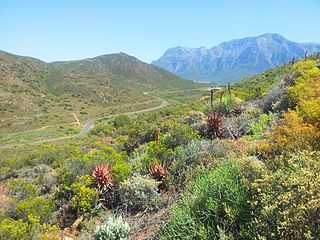
Robertson Karoo is a semi-arid vegetation type, restricted to sections of the Breede River Valley, Western Cape Province, South Africa. It is a subtype of Succulent Karoo and is characterised by the dominance of succulent plant species, and by several endemic plants and animals.

Euphorbia clavarioides, lion's spoor, anthill euphorbia, is a species of herbaceous plant in the family Euphorbiaceae. It is native to Botswana, Lesotho, and South Africa. It may grow to 18 cm in diameter, with a height of 30
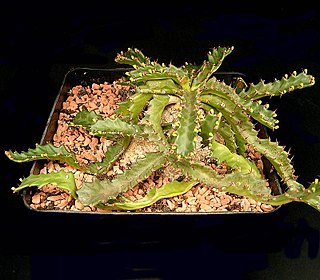
Euphorbia stellata is a species of flowering plant in the spurge family (Euphorbiaceae) endemic to the Eastern Cape of South Africa.
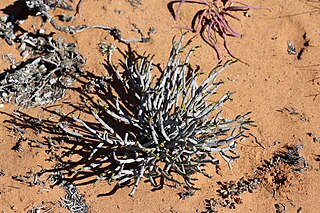
Euphorbia burmannii is a species of Euphorbia indigenous to Namibia and South Africa, where it is widespread in sandy soils, extending southwards to the Cape Peninsula and as far east as Grahamstown.
The Biodiversity of South Africa is the variety of living organisms within the boundaries of South Africa and its exclusive economic zone. South Africa is a region of high biodiversity in the terrestrial and marine realms. The country is ranked sixth out of the world's seventeen megadiverse countries, and is rated among the top 10 for plant species diversity and third for marine endemism.
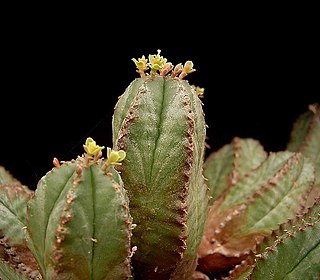
Euphorbia nesemannii, commonly known as Nesemann's euphorbia, is a species of plant in the family Euphorbiaceae native to the Western Cape province in South Africa.

Euphorbia bupleurifolia, commonly known as cycad spurge or pine cone plant, is a species of plant in the family Euphorbiaceae.

Euphorbia triangularis, commonly known as river naboom, river euphorbia, chandelier-tree or tree euphorbia, is a species of plant in the family Euphorbiaceae native to southern Africa.

Euphorbia grandidens, commonly known as valleybush euphorbia or large-toothed euphorbia, is a species of plant in the family Euphorbiaceae native to southern Africa.
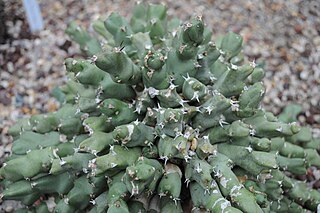
Euphorbia clivicola is a species of plant in the family Euphorbiaceae native to southern Africa.
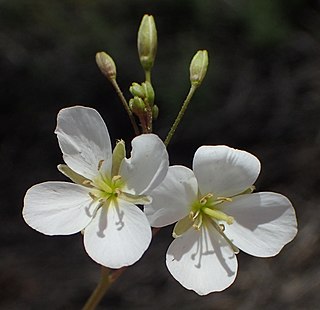
Heliophila variabilis is a species of flowering plant in the genus Heliophila.
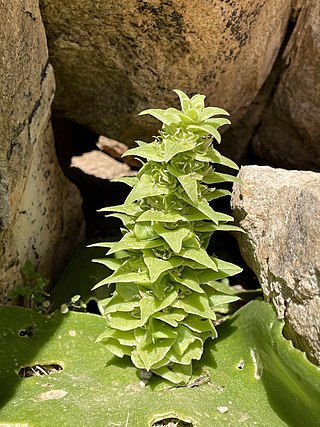
Massonia bifolia is a species of geophyte in the genus Massonia. It is native to southern Namibia and to the western Cape Provinces of South Africa.



















